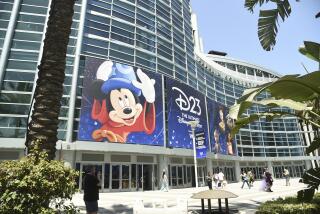ANALYSIS : Strictly Mickey Mouse : Disney Collectors Sale Spotlights Mass-Produced ‘Memorabilia’
- Share via
It looked as if Mickey Mouse was holding a garage sale at the Anaheim Grand Hotel on Sunday morning.
Tables were piled high with toys, buttons, records, books, magazines, posters, jewelry and miscellaneous bric-a-brac as more than 1,000 people bought, sold and traded Disney-related merchandise at “Strictly Disney,” an event sponsored by the National Fantasy Fan Club.
The record prices paid in recent years at New York auction houses for Disney animation artwork, coupled with the enduring popularity of the Disney characters, has created a booming market in related memorabilia, or “Disneyana.” Many of the dealers at the event, which was held in the hotel’s Crystal and Premiere rooms, were collectors who had taken up selling part time to enable them to expand their collections.
This passion for “collectibles” is far from new: Consider the craze for tulips that swept the Netherlands in 1636-37. The introduction of the bulbs from Asia sparked a frenzy of buying, selling and collecting. Prices skyrocketed until people were paying the price of a house for a rare specimen. Then the market collapsed and speculators found their fortunes reduced to a handful of small, brown bulbs.
Like the Dutch tulip mania, Sunday’s event seemed to represent a largely artificial market that has been created by and for speculators and collectors.
Very little of the material on display was more than a decade old. The cream was skimmed off the market a decade ago, when wealthy and/or serious collectors bought up the surviving toys from the late ‘20s and early ‘30s. Almost all of the newer material is mass-produced plastic that lacks the fine craftsmanship that distinguishes older toys, like original Charlotte Clark Mickey Mouse dolls.
A large percentage of merchandise at Sunday’s event consisted of items created just for this market. Old Disney merchandise was made to be used; the sole purpose of these newer plates and spoons and figurines is to sit in someone’s collection. Acquiring them is like painting by number:Buy each one as it’s issued and eventually end up with a complete set.
There didn’t seem to be much correlation between the intrinsic value of an object and its price at the event. People were buying folders from press kits, buttons, character glasses from fast-food promotions, Disney annual reports and employee newsletters. Someone was selling straws in Mickey Mouse wrappers--the same kind still found at food-service stands throughout Disneyland. An old, empty ticket book had a $5 price tag. Anyone who bothered to walk across the street to the park could get many of the same things new for less money--or, in the case of the straws, for free.
Nor was all the merchandise what it was represented to be. Sloppily made cels of the characters from “Bambi” had labels declaring that they were hand-painted originals from a Disney production. Technically that’s true, but what the labels didn’t say was that these cels had been used to make slides for educational media and had no historic or artistic significance. Anyone who bought them--believing that they were getting valuable material from “Bambi” at a bargain price--will be disillusioned upon learning that the resale value is virtually nil.
When the bubble finally bursts, many of the people who attended “Strictly Disney” may be dismayed to find that their collections of buttons and plates and promotional glasses and newsletters have little more than sentimental value.


